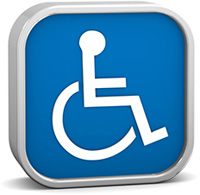Getting a Job
Job Search
USAJOBS
USAJOBS can provide great help in applying for non-competitive and competitive jobs by offering a wide variety of employment opportunity postings.
If you would like assistance specifically with USAJOBS, please contact them.
Students and Recent Graduates
The Workforce Recruitment Program, co-sponsored by the Department of Labor's Office of Disability Employment Policy and the Department of Defense, connects postsecondary students and recent graduates with disabilities to positions in the Federal government.
The Pathways Program provides paths for students and recent graduates, including those with disabilities, to internships and careers in the Federal Government.
Browse USAJOBS opportunities for students and recent graduates with and without disabilities.
University career centers and disability resource centers may have information on internships and federally sponsored student programs and related jobs.
Interview Process
Agencies make reasonable accommodations for applicants to provide full access to the application process. During the interview process, the hiring official should ask you questions about your job qualifications and how you would perform the essential functions of the job. Applicants are encouraged to present their qualifications in a positive manner which emphasizes abilities and assets. Sometimes an applicant will choose to anticipate and address job related questions about ways his or her disability may affect performance of critical duties, roles and responsibilities of the job.
Keep in mind that hiring officials are prohibited from asking questions about your disability unless the questions are related to functioning on the job and consistent with the business needs of the position. To review the Equal Employment Opportunity Commission's guidance about questions agencies can ask about an applicant's disability, please see the "Enforcement Guidance: Pre-employment Disability-Related Questions and Medical Examinations."
Questions?
If you have any questions about a job filled non-competitively, such as what to submit, how to apply or the status of your application, you may be interested in contacting the agency's Selective Placement Program Coordinator, Disability Program Manager or Human Resources Office.
If you have any questions about a job filled competitively, use the contact information in the USAJOBS vacancy announcement.
Additional Job Search Resources
Review the Equal Opportunity Publications, Inc. website to learn about a career guidance and recruitment magazine, online job board and career expos.
Agencies' websites also list job announcements. Browse a list of U.S. Government Departments and Agencies and find their websites.
Hiring Process
There are two types of hiring processes. In the non-competitive hiring process, agencies use a special authority (Schedule A) to hire persons with disabilities without requiring them to compete for the job. In the competitive process, applicants compete with each other through a structured process.
1. Start Job Search
Start your job search on USAJOBS. You can create an online résumé, or upload your résumé and relevant documents (e.g., college transcripts) on USAJOBS

2. Apply
Apply for jobs. Your online résumé/application is sent through USAJOBS. Indicate in your résumé that you also wish to apply under Schedule A.

3. Assess and Answer
You may have to take an assessment and/or answer questions relevant to your qualifications. Follow the instructions in the job announcement. Make sure you submit your résumé and all required documents because incomplete applications will be rejected.

4. Review
Your application will be reviewed to determine if you are eligible and qualified for the position you are applying for.

5. Notify
You will receive electronic notifications on the status of your application(s) throughout the hiring process.

6. Interviews
Qualified candidates are referred to the hiring official for potential interviews.

7. Accommodation for Interviews
If you are called for an interview and need an accommodation, please inform the hiring official before the interview.

8. Reference Check
The hiring official will conduct a reference check before a final decision is made.

9. Offer
If you are selected for the job, the human resources specialist will make you a tentative offer of employment and start a background investigation.

10. Request Accommodation
If you believe that you need an accommodation to participate in the application process or after you accept an offer of employment to perform the job's duties, let the agency know right away, according to the process(es) contained in the job announcement. Decisions on requests for accommodations are made on a case-by-case basis.

1. Contact Select Placement Program Coordinator
Contact the Selective Placement Program Coordinator (SPPC) at the agency you wish to work using the online directory. A listing of Federal agency sites can be found at www.usa.gov.

2. Submit
Submit your résumé, proof of your disability, and certification of job readiness directly to the agency's Selective Placement Program Coordinator. You must submit valid documentation regardless of the date of determination of your disability. If you do not have access to email, contact the Selective Placement Program Coordinator to find out the best way to submit your documents.

3. Follow-up
Follow-up with the Selective Placement Program Coordinator within a few weeks of your application to check on the status of your application.

4. Review
If the hiring official finds you to be a good fit for the job, you may be interviewed.

5. Interview
If you are called for an interview and need an accommodation, please inform the hiring official before the interview.

6. Reference Check
The hiring official will conduct a reference check before a final decision is made.

7. Offer
If you are selected for the job, the human resources specialist will make you a tentative offer of employment and start a background investigation.

8. Request Accommodation
If you accept an offer of employment and believe you will need an accommodation to perform the job's duties, let the agency know immediately to ensure you have what you need on your first day.

Schedule A Hiring Authority
Schedule A is a special (excepted) hiring authority for persons with disabilities.
While being eligible for a Schedule A appointment will help you in the noncompetitive process, it will NOT guarantee you a job.
You may be subject to a probationary period can last up to two years, depending on the type of appointment. During probation, employees hired under the Schedule A are held to the same performance standards as all other employees.
Proving Eligiblity
You are eligible for Schedule A if you are a person with severe physical disability, a psychiatric disability or an intellectual disability. Still unsure if your disability qualifies you for Schedule A? To prove your eligibility to be appointed to a federal job under Schedule A, you must:
- Be qualified for the job for which you are applying (i.e., have the necessary competencies and relevant experience to perform the job).
- Provide "proof of a disability" documentation. "Proof of a disability" is a letter stating that you have an intellectual disability, severe physical disability or psychiatric disability. You can get this letter from your doctor, a licensed medical professional, a licensed vocational rehabilitation specialist, or any Federal, state, or local agency that issues or provides disability benefits. Many doctors and most of the entities listed above know how to format a Schedule A letter.
Related Information
Sample Letters
View sample Schedule A letters for use by the individual developing your documentation.
Guide to Schedule A
Guide to Schedule A for job applicants created by the U.S. Equal Employment Opportunity Commission




